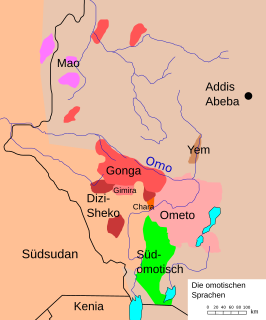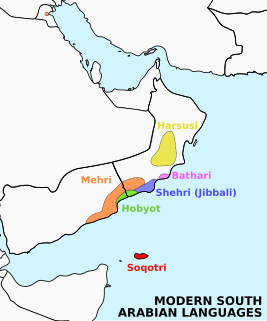Related Research Articles

Afroasiatic (Afro-Asiatic), also known as Afrasian or Hamito-Semitic, Semito-Hamitic, or Erythraean, is a large language family of about 300 languages that are spoken predominantly in Western Asia, North Africa, the Horn of Africa and parts of the Sahel. With the exception of Semitic, all branches of the Afroаsiatic family are spoken exclusively on the African continent.

The Chadic languages form a branch of the Afroasiatic language family. They are spoken in parts of the Sahel. They include 150 languages spoken across northern Nigeria, southern Niger, southern Chad, the Central African Republic, and northern Cameroon. The most widely spoken Chadic language is Hausa, a lingua franca of much of inland Eastern West Africa.

The Cushitic languages are a branch of the Afroasiatic language family. They are spoken primarily in the Horn of Africa, with minorities speaking Cushitic languages to the north in Egypt and the Sudan, and to the south in Kenya and Tanzania. As of 2012, the Cushitic languages with over one million speakers were Oromo, Somali, Beja, Afar, Hadiyya, Kambaata, Saho, and Sidama.

The Omotic languages are a group of languages spoken in southwestern Ethiopia. The Ge'ez script is used to write some of the Omotic languages, the Latin script for some others. They are fairly agglutinative and have complex tonal systems. The languages have around 6.2 million speakers. The group is generally classified as belonging to the Afroasiatic language family, but this is disputed by some.
Lowland East Cushitic is a group of roughly two dozen diverse languages of the Cushitic branch of the Afro-Asiatic family. Its largest representatives are Somali and Oromo.
Konso is a Lowland East Cushitic language spoken in southwest Ethiopia. Native speakers of Konso number about 200,000. Konso is closely related to Dirasha, and serves as a "trade language"—or lingua franca—beyond the area of the Konso people. Blench (2006) considers purported dialects Gato and Turo to be separate languages.
Bussa, or Mossiya, is a Cushitic language spoken in the Dirashe special woreda of the Southern Nations, Nationalities, and People's Region located in southern Ethiopia. The people themselves, numbering 18,000 according to the 2007 census, call their language Mossittaata.

The Modern South Arabian, or Eastern South Semitic languages, are a group of endangered languages spoken by small populations inhabiting the Arabian Peninsula, in Yemen and Oman, and Socotra Island. Together with the modern Ethiopian Semitic languages, the Western branch, they form the South Semitic sub-branch of the Afroasiatic language family's Semitic branch.
The languages of Ethiopia include the official languages of Ethiopia, its national and regional languages, a large number of minority languages, as well as foreign languages.
Libido is an Afroasiatic language of Ethiopia, which is spoken in the Mareko district Gurage Zone of the Southern Nations, Nationalities, and People's Region, directly south-east of Butajira. It has about 64,000 native speakers.
Boon or Af-Boon is a nearly extinct Cushitic language spoken by 59 people in Jilib District, Middle Jubba Region, Somalia. In recent decades they have shifted to the Maay dialect of Jilib. All speakers are older than 60.
The Tsamai people are an ethnic group of southwestern Ethiopia. They speak a Cushitic language called Tsamai, which is one of the Dullay languages, and thus related to the Bussa and Gawwada languages.
Dirasha is a member of the Cushitic branch of the Afro-Asiatic family. It is spoken in the Omo region of Ethiopia, in the hills west of Lake Chamo, around the town of Gidole.
Alaba-Kʼabeena, also known as Wanbasana, is a Highland East Cushitic language spoken in Ethiopia by the Alaba and Kebena peoples in the Great Rift Valley southwest of Lake Shala, specifically in Alaba special district, the Kebena district of Gurage Zone, and the Goro district of Oromia Region. The literacy rate of native speakers in their language is below 1%, while their literacy rate in second languages is 8.6%; Alaba-Kʼabeena is taught in primary schools. It has an 81% lexical similarity with Kambaata. However, Fleming (1976) classifies Kʼabeena as a dialect of Kambaata, and Blench (2006) classifies both as dialects of Kambaata. The 2007 census in Ethiopia lists Alaba and Qebena as separate languages.
The Dullay languages belong to the Cushitic subgroup of the Afro-Asiatic language family and are spoken in Ethiopia. Dullay is a dialect continuum consisting of the Gawwada and Tsamai languages. Blench (2006) places most of Bussa in the Konsoid languages, and counts several Gawwada varieties as distinct languages.
The Omo–Tana languages are a branch of the Cushitic family and are spoken in Ethiopia, Djibouti, Somalia and Kenya. The largest member is Somali. There is some debate as to whether the Omo–Tana languages form a single group, or whether they are individual branches of Lowland East Cushitic. Blench (2006) restricts the name to the Western Omo–Tana languages, and calls the others Macro-Somali.
Maʼa is a Bantu language of Tanzania.
The Macro-Somali or Somaloid languages, or, Sam languages, are a branch of the Lowland East Cushitic languages in the classification of those who do not accept the unity of Omo–Tana. They are spoken in Somalia, Somaliland, Djibouti, eastern Ethiopia, and northern Kenya. The most important member is Somali.
The Oromoid languages are a branch of Lowland East Cushitic languages that includes the most populous Cushitic language, Oromo, and the closely related Konsoid dialect cluster.
Girirra also called Gariire is a Cushitic language of Ethiopia. It has extensive borrowing from Somali.Although not mutually intelligible with Somali, it is estimated that around 70% of the Garirra language is made up of Somali loan words. There has not been many studies on the language itself and is often grouped into a small umbrella of the Macro-Somali language family including relatives like: Rendille, Boni, Bayso, and the two dialects of Somali, being Af-Maay, and Af-Maxaa.
References
- ↑ Bussa less Mashile and Mosiye Ethiopia 2007 Census Archived November 13, 2012, at the Wayback Machine
- ↑ Blench, 2006. The Afro-Asiatic Languages: Classification and Reference List (ms)